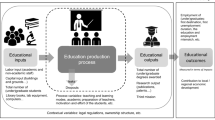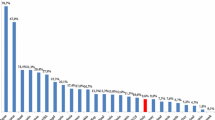Abstract
Assessing university resource allocation or misallocation is necessary to understand its impact on research and teaching productivity. To achieve this insight, this study conducts a two-stage data envelopment analysis to judge the “teaching and research efficiency” and “revenue efficiency” of 61 universities in Vietnam. We analyze what variables have the most effect on the efficiencies of the universities through improving results. Moreover, this research applies scale elasticity to distinguish the benchmark performance leader among Vietnam universities. Results indicate that universities are more efficient in terms of “revenue efficiency” than “teaching and research efficiency.” The scale elasticity decomposition findings show that multidisciplinary universities perform better than those specializing in science and technology and social science and economics. Finally, the competitive map to performance advancement strategies is exhibited. This map helps the university management to enhance their efficiencies.


Similar content being viewed by others
Notes
RTS explains what happens as scale effects change when inputs are variable in a production function. Three possibilities exist: increasing, constant, and decreasing RTS.
References
Agasisti, T., Catalano, G., Landoni, P., & Verganti, R. (2012). Evaluating the performance of academic departments: An analysis of research-related output efficiency. Research Evaluation,21(1), 2–14.
Ahn, T., Charnes, A., & Cooper, W. W. (1988). Some statistical and DEA evaluations of relative efficiencies of public and private institutions of higher learning. Socio-Economic Planning Sciences,22(6), 259–269.
Altamirano-Corro, A., & Peniche-Vera, R. (2014). Measuring the institutional efficiency using DEA and AHP: The case of a Mexican university. Journal of Applied Research and Technology,12(1), 63–71.
Avkiran, N. K. (2001). Investigating technical and scale efficiencies of Australian universities through data envelopment analysis. Socio-Economic Planning Sciences,35(1), 57–80.
Banker, R. D., Charnes, A., & Cooper, W. W. (1984). Some models for estimating technical and scale inefficiencies in data envelopment analysis. Management Science,30(9), 1078–1092.
Baumol, W. J. (1982). Applied fairness theory and rationing policy. The American Economic Review,72(4), 639–651.
Bayraktar, E., Tatoglu, E., & Zaim, S. (2013). Measuring the relative efficiency of quality management practices in Turkish public and private universities. Journal of the Operational Research Society,64(12), 1810–1830.
Breu, T. M., & Raab, R. L. (1994). Efficiency and perceived quality of the nation's “top 25” National Universities and National Liberal Arts Colleges: An application of data envelopment analysis to higher education. Socio-Economic Planning Sciences,28(1), 33–45.
Castano, M. C. N., & Cabanda, E. C. (2007). Performance evaluation of the efficiency of Philippine Private Higher Educational Institutions: application of frontier approaches. International Transactions in Operational Research,14(5), 431–444.
Casu, B., & Thanassoulis, E. (2006). Evaluating cost efficiency in central administrative services in UK universities. Omega,34(5), 417–426.
Chanh (2015). Education in South Vietnam 1954–1975 on the path of construction and development. Retrieved from https://khoavanhoc-ngonngu.edu.vn/home/index.php?option=com_content&view=article&id=5227%3Agiao-dc-min-nam-vit-nam-1954-1975-tren-con-ng-xay-dng-va-phat-trin&catid=115%3Agiao-dc&Itemid=189&lang=vi.
Charnes, A., Cooper, W. W., & Rhodes, E. (1978). Measuring the efficiency of decision making units. European Journal of Operational Research,2(6), 429–444.
Chen, J., Zhang, Y., & Yin, Z. (2018). Education premium in the online peer-to-peer lending marketplace: Evidence from the big data in China. The Singapore Economic Review,63(01), 45–64.
Chen, Y., Cook, W. D., Li, N., & Zhu, J. (2009). Additive efficiency decomposition in two-stage DEA. European Journal of Operational Research,196(3), 1170–1176.
Chu Ng, Y., & Li, S. K. (2000). Measuring the research performance of Chinese higher education institutions: An application of data envelopment analysis. Education Economics,8(2), 139–156.
Cook, W. D., Zhu, J., Bi, G., & Yang, F. (2010). Network DEA: Additive efficiency decomposition. European Journal of Operational Research,207(2), 1122–1129.
Cooper, W. W., Li, S., Seiford, L. M., Tone, K., Thrall, R. M., & Zhu, J. (2001). Sensitivity and stability analysis in DEA: Some recent developments. Journal of Productivity Analysis,15(3), 217–246.
Duh, R.-R., Chen, K.-T., Lin, R.-C., & Kuo, L.-C. (2014). Do internal controls improve operating efficiency of universities? Annals of Operations Research,221(1), 173–195.
Färe, R., & Grosskopf, S. (2000). Network DEA. Socio-Economic Planning Sciences,34(1), 35–49.
Farrell, M. J. (1957). The measurement of productive efficiency. Journal of the Royal Statistical Society Series A (General),120(3), 253–290.
Fernando, B. I. S., & Cabanda, E. C. (2007). Measuring efficiency and productive performance of colleges at the University of Santo Tomas: A nonparametric approach. International Transactions in Operational Research,14(3), 217–229.
Flegg, A., Allen, D., Field, K., & Thurlow, T. (2004). Measuring the efficiency of British universities: A multi-period data envelopment analysis. Education Economics,12(3), 231–249.
Fu, T.-T., & Huang, M.-Y. (2009). Performance ranking and management efficiency in colleges of business: A study at the department level in Taiwanese universities. In D. Lee (Ed.), Productivity, efficiency, and economic growth in the Asia-Pacific region (pp. 197–215). New York: Springer.
Galagedera, D. U., Watson, J., Premachandra, I., & Chen, Y. (2016). Modeling leakage in two-stage DEA models: An application to US mutual fund families. Omega,61, 62–77.
Hien, P. D. (2010). A comparative study of research capabilities of East Asian countries and implications for Vietnam. Higher Education,60(6), 615–625.
Hien, T. D. (2017). Renovating public higher education autonomy mechanism in the period of 2015–2017: Results and policy recommendations. Retrieved from https://tapchitaichinh.vn/nghien-cuu--trao-doi/trao-doi-binh-luan/doi-moi-co-che-tu-chu-giao-duc-dai-hoc-cong-lap-giaidoan-20152017-ket-qua-va-kien-nghi-chinh-sach-133327.html.
Hoa, M. N. (2018). Where is Vietnam University standing? Retrieved from https://tuoitre.vn/dh-viet-nam-dang-dung-o-dau-20180210085142507.html.
Johnes, J. (2006). Measuring teaching efficiency in higher education: An application of data envelopment analysis to economics graduates from UK Universities 1993. European Journal of Operational Research,174(1), 443–456.
Johnes, J., & Johnes, G. (1995). Research funding and performance in UK university departments of economics: A frontier analysis. Economics of Education Review,14(3), 301–314.
Johnes, J., Portela, M., & Thanassoulis, E. (2017). Efficiency in education. Journal of the Operational Research Society,68(4), 331–338.
Kao, C. (2009). Efficiency decomposition in network data envelopment analysis: A relational model. European Journal of Operational Research,192(3), 949–962.
Kao, C., & Hung, H.-T. (2008). Efficiency analysis of university departments: An empirical study. Omega,36(4), 653–664.
Kao, C., & Hwang, S.-N. (2008). Efficiency decomposition in two-stage data envelopment analysis: An application to non-life insurance companies in Taiwan. European Journal of Operational Research,185(1), 418–429.
Korhonen, P., Tainio, R., & Wallenius, J. (2001). Value efficiency analysis of academic research. European Journal of Operational Research,130(1), 121–132.
Kuah, C. T., & Wong, K. Y. (2013). Data Envelopment Analysis modeling for measuring knowledge management performance in Malaysian higher educational institutions. Information Development,29(3), 200–216.
Liang, L., Wu, J., Cook, W. D., & Zhu, J. (2008). Alternative secondary goals in DEA cross-efficiency evaluation. International Journal of Production Economics, 113(2), 1025–1030.
Liu, J. S., & Lu, W. M. (2012). Network-based method for ranking of efficient units in two-stage DEA models. Journal of the Operational Research Society,63(8), 1153–1164.
Liu, J. S., Lu, W. M., Yang, C., & Chuang, M. (2009). A network-based approach for increasing discrimination in data envelopment analysis. Journal of the Operational Research Society,60(11), 1502–1510.
Lu, W.-M. (2012). Intellectual capital and university performance in Taiwan. Economic Modelling,29(4), 1081–1089.
Martín, E. (2006). Efficiency and Quality in the Current Higher Education Context in Europe: An application of the data envelopment analysis methodology to performance assessment of departments within the University of Zaragoza. Quality in Higher Education,12(1), 57–79.
MOET (2017). Higher education statistics for the 2016–2017 school year. Retrieved from https://www.moet.gov.vn/thong-ke/Pages/thong-ko-giao-duc-dai-hoc.aspx?ItemID=5137.
Nga, D. T. (2017). State investment in education and training: Current situation and some proposals. Retrieved from https://tapchitaichinh.vn/nghien-cuu-trao-doi/dau-tu-cua-nha-nuoc-cho-giao-duc-dao-tao-thuc-trang-va-mot-so-de-xuat-130918.html.
Nguyễn. (2006). Education in South Vietnam before 1975. Santa Ana, CA: Lê Văn Duyệt Foundation.
Premachandra, I., Zhu, J., Watson, J., & Galagedera, D. U. (2012). Best-performing US mutual fund families from 1993 to 2008: Evidence from a novel two-stage DEA model for efficiency decomposition. Journal of Banking & Finance,36(12), 3302–3317.
Quang (2016). 225,000 bachelors of unemployment and the cost of a sluggish education. Retrieved from https://giaoduc.net.vn/giao-duc-24h/225000-cu-nhan-that-nghiep-va-cai-gia-phai-tra-cua-mot-nen-giao-duc-i-ach-post165246.gd.
Sahoo, B. K., Zhu, J., Tone, K., & Klemen, B. M. (2014). Decomposing technical efficiency and scale elasticity in two-stage network DEA. European Journal of Operational Research,233(3), 584–594.
Sav, G. T. (2012). Four-stage DEA efficiency evaluations: Financial reforms in public university funding. International Journal of Economics and Finance,5(1), 24.
Schwab, K. (2016). The Global Competitiveness Report 2016–2017. Geneva: World Economic Forum.
Seiford, L. M., & Zhu, J. (1999). Profitability and marketability of the top 55 US commercial banks. Management Science,45(9), 1270–1288.
Thanassoulis, E., Dey, P. K., Petridis, K., Goniadis, I., & Georgiou, A. C. (2017). Evaluating higher education teaching performance using combined analytic hierarchy process and data envelopment analysis. Journal of the Operational Research Society,68(4), 431–445.
Tone, K., & Tsutsui, M. (2009). Network DEA: A slacks-based measure approach. European Journal of Operational Research,197(1), 243–252.
Tran, C. D. T., & Villano, R. A. (2015). Measuring efficiency of Vietnamese public colleges: An application of the DEA-based dynamic network approach. International Transactions in Operational Research.,25, 683–703.
Tran, C. D. T., & Villano, R. A. (2017a). An empirical analysis of the performance of Vietnamese higher education institutions. Journal of Further and Higher Education,41(4), 530–544.
Tran, C. D. T., & Villano, R. A. (2017b). Input Rigidities and Performance of Vietnamese Universities. Asian Economic Journal,31(3), 253–273.
Trung, X. (2016). Mr. Tran Duc Canh pointed out the “spearhead” and “prison” sector in higher education. Retrieved from https://giaoduc.net.vn/giao-duc-24h/ong-tran-duc-canh-chi-ra-nganh-mui-nhon-va-mui-tu-trong-giao-duc-dai-hoc-post166809.gd.
Turner, D. (2005). Benchmarking in universities: League tables revisited. Oxford Review of Education,31(3), 353–371.
Vistacollege. (2019). The Importance of Higher Education in the 21st Century. Retrieved from https://www.vistacollege.edu/blog/resources/higher-education-in-the-21st-century/.
Author information
Authors and Affiliations
Corresponding author
Additional information
Publisher's Note
Springer Nature remains neutral with regard to jurisdictional claims in published maps and institutional affiliations.
Rights and permissions
About this article
Cite this article
Tran, P.P., Kuo, KC., Lu, WM. et al. Benchmarking in Vietnam universities: teaching and research and revenue efficiencies. Asia Pacific Educ. Rev. 21, 197–209 (2020). https://doi.org/10.1007/s12564-019-09622-z
Received:
Revised:
Accepted:
Published:
Issue Date:
DOI: https://doi.org/10.1007/s12564-019-09622-z




